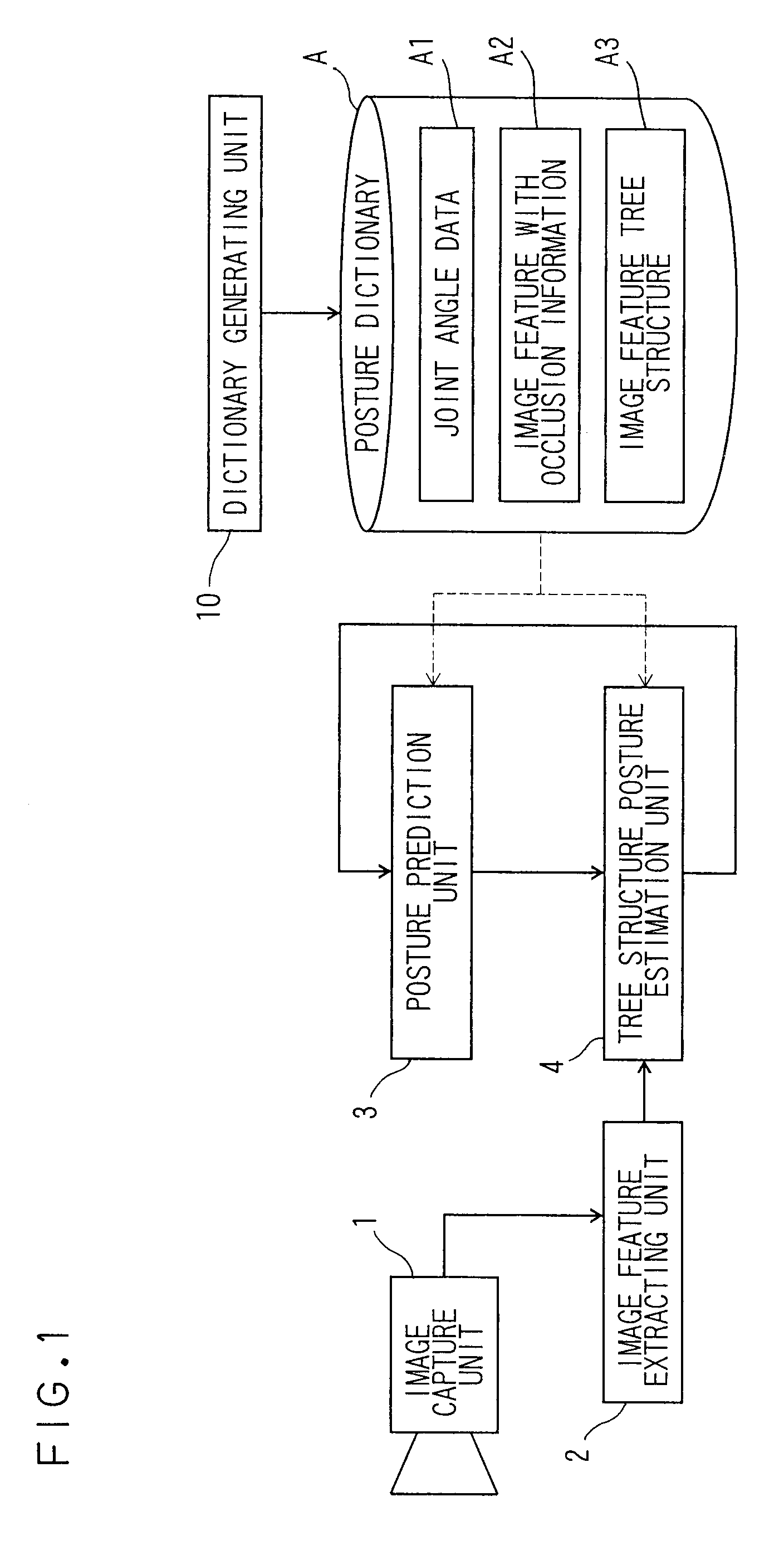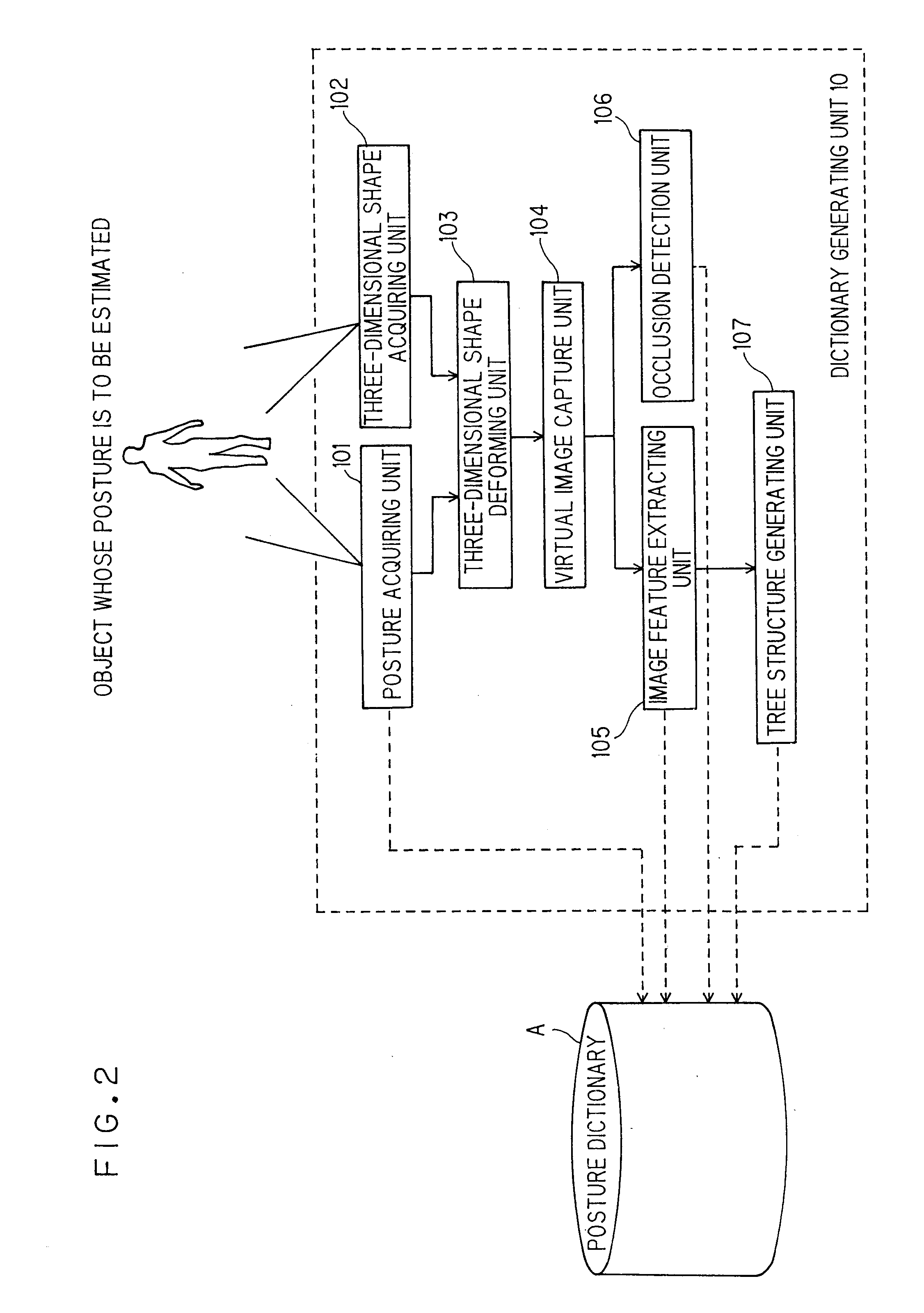Posture estimation apparatus and method of posture estimation
a posture estimation and posture technology, applied in the field of noncontact posture estimation apparatus, can solve the problems of inability to realize a single camera, difficult to extract the positions of various posture feature points, and redundant search, so as to improve the robustness of posture estimation, efficient posture search, and reduce the effect of constraint of temporal continuity
- Summary
- Abstract
- Description
- Claims
- Application Information
AI Technical Summary
Benefits of technology
Problems solved by technology
Method used
Image
Examples
modification 1
(6) Modification 1
[0087]The number of cameras is not limited to one, and a plurality of the cameras may be used.
[0088]In this case, the image capture unit 1 and the virtual image capture unit 104 consist of the plurality of cameras, respectively. Accordingly, the image feature extracting unit 2 and the image feature extracting unit 105 perform processing for the respective camera images, and the occlusion detection unit 106 sets the occlusion flags for the portions occluded from all the cameras.
[0089]The image feature distances (the silhouette distance or the outline distance) calculated by the tree structure generating unit 107 and the similarity calculating unit 42 are also calculated for the respective camera images, and an average value is employed as the image feature distance. The silhouette information, the outline information to be registered in the posture dictionary A, and the background information used for the background difference processing by the observed silhouette e...
modification 2
(7) Modification 2
[0090]When performing the search using the tree structure, a method of calculating the similarity using a low resolution for the upper levels and a high resolution for the lower levels is also applicable.
[0091]With the adjustment of the resolution as such, the calculation cost for calculating the similarity in the upper levels is reduced, so that the search efficiency may be increased.
[0092]Since the image feature distance between the nodes is large in the upper levels, the risk of obtaining a local optimal solution increases if the search is performed by calculating the similarity with the high resolution. In terms of this point, the adjustment of the resolution as described above is effective.
[0093]When the plurality of resolutions are employed, the image features relating to all the resolutions are obtained by the image feature extracting unit 2 and the image feature extracting unit 105. The silhouette information and the outline information on all the resolutio...
modification 3
(8) Modification 3
[0094]Although the silhouette and the outline are used as the image features in the embodiment shown above, it is also possible to use only the silhouette or only the outline.
[0095]When only the silhouette is used, the silhouette is extracted by the image feature extracting unit 105, and the tree structure is generated on the basis of the silhouette distance by the tree structure generating unit 107.
[0096]The outline may be divided into to boundaries; a boundary with the background (the thick solid line in FIG. 5) and a boundary with other portions (the thick dot line in FIG. 5). However, since the boundary with the background includes information overlapped with the silhouette, the outline distance may be calculated using only the boundary with other portions by the similarity calculating unit 42.
(9) Other Modifications
[0097]The invention is not limited to the embodiments shown above, and may be embodied by modifying components without departing from the scope of ...
PUM
 Login to View More
Login to View More Abstract
Description
Claims
Application Information
 Login to View More
Login to View More - R&D
- Intellectual Property
- Life Sciences
- Materials
- Tech Scout
- Unparalleled Data Quality
- Higher Quality Content
- 60% Fewer Hallucinations
Browse by: Latest US Patents, China's latest patents, Technical Efficacy Thesaurus, Application Domain, Technology Topic, Popular Technical Reports.
© 2025 PatSnap. All rights reserved.Legal|Privacy policy|Modern Slavery Act Transparency Statement|Sitemap|About US| Contact US: help@patsnap.com



